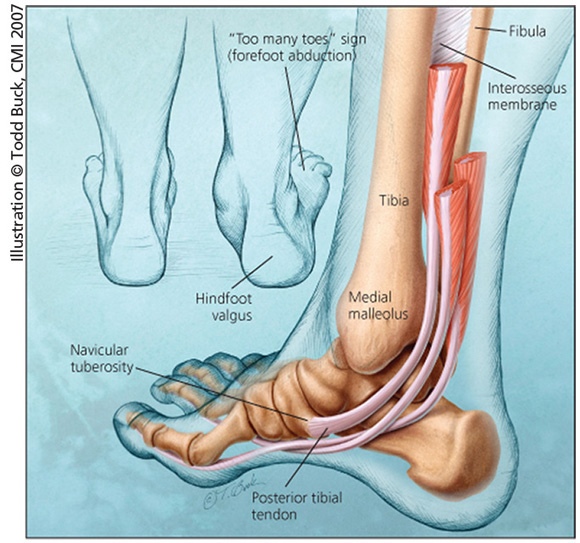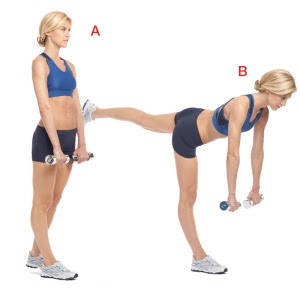
Posterior Tibial Tendon Disorder
Those who suffer from Posterior Tibial Tendon Disorder (PTTD) can experience pain, inflammation, and collapsing of the medial arches.
When stretched from its normal state, the Posterior Tibial Tendon (PTT) lacks the ability to support and stabilize the medial arch. Strenuous pressure on this tendon without continual support will increase the chances of it being completely torn.
Most circumstances of PTTD can effectively be treated and prevented with orthotics and custom foot orthoses. Very few cases are so severe that surgical intervention is required.
In order to support this vulnerable tendon, an orthotic should be rigid and wide enough to prevent further collapse of the tendon. Orthotic intervention can have an immense effect in the prevention of PTTD.
Footmaxx offers a variety of orthotic specializations that can provide that support and take the pressure off of the weak tendon. An example would be an orthotic that offers a wide medial flange that can prevent further strain on the tendon by supporting the medial arch.
Prevention includes wearing orthotics and proper footwear. Patients should wear shoes that offer medial arch support with a firm heel counter, especially during rigorous activity. Wearing proper shoes and custom orthotics to prevent and treat this frequent injury is a proactive way to avoid surgery and long-term instability.
Call Richmond Chiropractic Centre to schedule a free gait analysis. 604-270-1007

As your little ones prepare their costumes to trick or treat their way through the night, the Canadian Red Cross has prepared a quick list of 10 tips to make sure everyone gets home safely. You may not need to fear vampires and ghosts knocking on your door, but fire hazards, scrapes and getting lost are potential concerns.
1) Give your kids a map of their trick or treat route so they can find their way home. Mark the homes of nearby friends and relatives in case they need assistance on their journey. Younger children should be chaperoned by an adult.
2) Instruct children to walk on the sidewalk not the street – even princesses and fairies have to watch out for motorists!
3) Prepare for the dark with lighter coloured clothing and reflective surfaces. What better way to decorate a sword or a cape than with magical glowing tape?
4) Avoid any type of flame by substituting candles with glow sticks. Wigs and costumes are highly flammable and glow sticks are perfect for illuminating Jack-o-lanterns.
5) Remind your kids to stick with groups of at least four or five – after all, even legendary heroes are stronger as a team (like the Avengers and X-Men!)
6) Tell them to only visit residences with a porch light on and not to enter a stranger’s home – politely accept candy and promptly leave.
7) Costumes are meant to embellish – not to hide. Keep hems short to avoid tripping and don’t let masks block the eyes.
8) Whether you have one eye, two eyes, three eyes or four, always look both ways before crossing the street.
9) Both mystical creatures and children need to let parents check their candy before eating to remove any potential hazards.
10) A flashlight is akin to a protective light saber of sorts and makes nighttime travelling safer (it also helps you spot a ghost or goblin trying to plan a surprise attack!)
Following these tips on October 31 will help ensure your family has a fun and safe night of trick or treating.
Happy Trick or Treating!!!! Have a Spooktacular Day.

Ball Dumbbell Press
Lie on your back, shoulder blades on top of the exercise ball, back extended, knees flexed at 90 degree angles and hold dumbbells on each side of your chest.
Push the dumbbells straight up and slowly lower them down after a short pause.
Breathe out while pushing and breathe in while returning to starting position.

Stability ball V-pass
Lie faceup on the floor, holding a stability ball overhead with both hands, your legs together and extended straight on the floor (a). In one motion, brace your core and lift your arms and legs off the ground, placing the ball between your feet (b). Squeeze the ball with your legs and lower your arms and legs back to the floor (c). Repeat, passing the ball back to your hands. That’s one rep. Do eight to 10.
Alternate-Leg Dead Lift

Hold a 5- to 15-pound dumbbell in each hand and stand on your right leg, lifting your left leg a few inches behind you (a). Keeping your back straight, lean forward from your hips until your body is almost parallel to the floor, the weights in line with your shoulders (b). Return to start. That’s 1 rep. Do 12, then switch legs.









